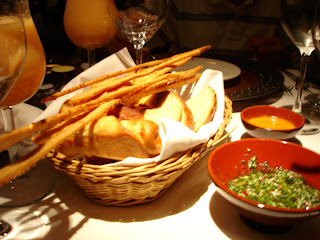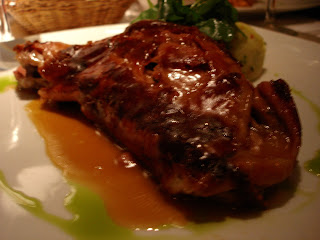 I haven't done much traveling since I started this blog back in April. In fact, I didn't realize how big a part of my life food was until three or so years ago. Therefore, I have never traveled before with quite the intensity and commitment to culinary excellence as I did this last week during my trip to Peru. Luckily, I realized this before Peru, which has so many gastronomic pleasures to offer. When my mom asked me to find activities in Lima, I found restaurants instead. Prowling the Chowhound boards, I came up with a list of over twenty restaurants around the country at the cities we would be visiting from Lima, Cusco, Agua Calientes, and Puno. I figured with this list, I would have somewhere to go wherever we stayed. But with such an impressive list, I wanted to ensure that I hit up at least one place--Astrid y Gaston.
I haven't done much traveling since I started this blog back in April. In fact, I didn't realize how big a part of my life food was until three or so years ago. Therefore, I have never traveled before with quite the intensity and commitment to culinary excellence as I did this last week during my trip to Peru. Luckily, I realized this before Peru, which has so many gastronomic pleasures to offer. When my mom asked me to find activities in Lima, I found restaurants instead. Prowling the Chowhound boards, I came up with a list of over twenty restaurants around the country at the cities we would be visiting from Lima, Cusco, Agua Calientes, and Puno. I figured with this list, I would have somewhere to go wherever we stayed. But with such an impressive list, I wanted to ensure that I hit up at least one place--Astrid y Gaston.As you will see in this series of entries on Peruvian cuisine, the appeal is often in the cultural hodgepodge that comprises this South American country. Three main regions contribute heavily: the coast, highlands, and jungle. From the coast, we get fresh seafood forming such dishes as the ceviche and tiradito, a subtler cousin of ceviche more similar to Italian crudo or Japanese sashimi. The jungle provides an assortment of fruits and vegetables, many unfamiliar to us in the States. Up in the highlands, the cultivation of potatoes and other hardy plants combine with alpaca and guinea pig. One of the reasons I was so interested in Astrid y Gaston was its extensive menu encompassing multiple cultures and all these regions together.
This was my first time making a reservation for a restaurant in another country in a language I haven't used since high school. Luckily, Astrid y Gaston has a website with convenient English and a reservation submission form. However, as my trip approached, I still hadn't received an e-mail confirmation as stated on the site. When I got to Lima, I asked the helpful concierge to confirm the reservation for me. We got to the restaurant with no problem, its location being not too far from the hotel in Miraflores.
The interior of the restaurant could have been in any metropolis in the world. A team of professional waitstaff attended to our every need, including replacing my dad's silverware after each of the four times he dropped it. Diners can look back into the kitchen, with modern art lining the walls. The dining set of assorted plates were different for each table. The food was comparably expensive, more than ten times the cost of our cheapest meals. This was a place for the Liman elite and globetrekking tourists.

That is my brother sitting across from me
In Peru, as in many other countries, the classiest restaurants charge for bread. While that may sound ridiculous to me, I am at least assured that they will provide bread worth paying for. I wasn't disappointed. A collection of corn, potatoes and regular wheat bread was presented by the waiter paired with a dipping sauce of garlic cilantro and an unidentified spicy one. It was even served to us as a course, with the server explaining each component of the basket. The various baked goods were satisfying, but dangerous to the hungry customer. I needed to conserve my stomach if I was going to be eating here. The portions were enormous.

As an appetizer, I ordered the Limeña, a golden potato puree formed into neat stacks with tuna, crab, avocado and spicy cream. While the plate of four indeed looked pretty, the taste was underwhelming. On the bright side, I could actually taste some complexity in the potato that is largely absent from the varieties we have in this country.

Initially, I wanted to try the roasted kid for my entree. That's kid as in young goat. While I could've said goat, there wouldn't be that glee from the momentary shock on people's faces when you tell of your meal of kid. However, my brother was much more adament about ordering it; and so in the interest of diversity, I ordered the el asado de tira y el maiz morado--beef short ribs with purple corn in a red wine reduction and baby corn. The picture is as unappetizing as the ribs. They were simultaneously burnt and cold. Not quite what I was expecting or hoping for.

But to redeem my dish, the other three entrees were phenomenol. As a side note, in Peru, as in Britain, entree refers to the appetizer, causing much confusion for me and my Spanish speaking waiter. I let my brother have the nuestro clasico cabrito lechal del del valle de chillon--roasted kid in purple corn juice with Huamantanga potatoes. Come to think of it, many of the names of our dishes were quite a mouthful. His was my favorite item of that dinner. The meant was succulent and tender with a full flavor in the meat absent from the bland livestock we're used to. It's the most expensive entree there, but well worth it.

My mom had the Pachamanca urbana--a whole chicken cooked in an earthen pot with Andean herbs and potatoes. While a simple looking dish, besides service in said large pot, the chicken had so much flavor that I could hardly recognize the poultry we see so commonly here. While Pachamanca is traditionally reserved for feasts and celebrations in the Andes, served communally, this urbana version was just split between us four. I also doubt they prepared underground on a bed of hot stones as it should be, but no complaints here.

For my dad, I ordered the conchinillo de tres semanas del invierno--a suckling pig confit prepared for three weeks in a cocoa reduction and served with a poached peach. The skin was crispy if not for the sauce, but the meat as tender as a suckling pig should be. I am constantly disappointed I can't find quality pork like this more often without paying for Kurobuta or Berkshire.

For dessert, I wanted to try something fruity to encompass their wide selection of produce. I already had a melon juice with my meal which was fragrant and complex, but we decided to try the three flavor seasonal sorbets for dessert. While the menu lists 5-6 fruits, the ones we got are prickly pear (aka tuna verde), lemongrass with lemon and passionfruit. The prickly pear turned out to be the winner, light on the palate, while the lemongrass was much too sour and the passionfruit lacked depth. With the check came another little treat of chocolate truffles and candied fruits.


I would highly recommend anyone on their way to Lima to make a trip to Astrid y Gaston. It really is a fine experience and a good way to get your feet with to all that Lima has to offer. I don't know if I would return immediately, but that is only because there are so many other restaurants to try. However, I wouldn't be surprised if this represented the most progressive cuisine the country has to offer.
Astrid y Gaston
www.astridygaston.com
Calle Cantuarias 175, Miraflores
Entrees were about US$21
0 comments:
Post a Comment